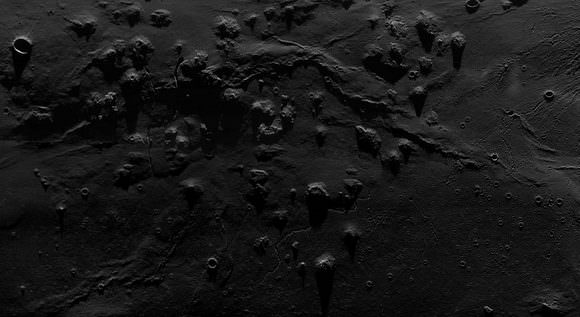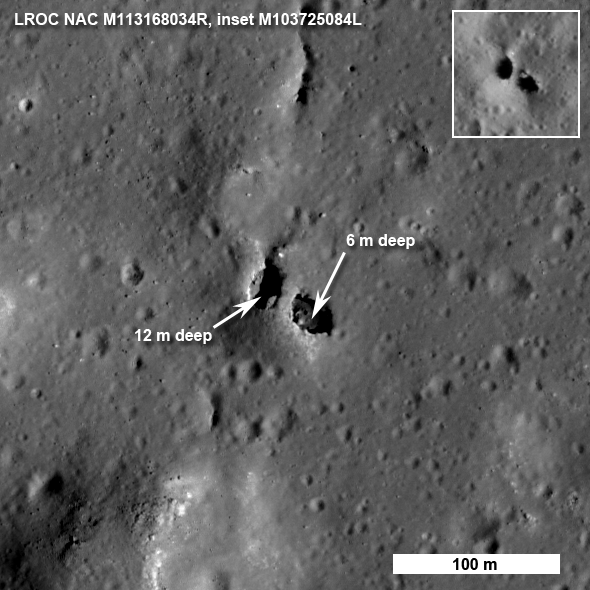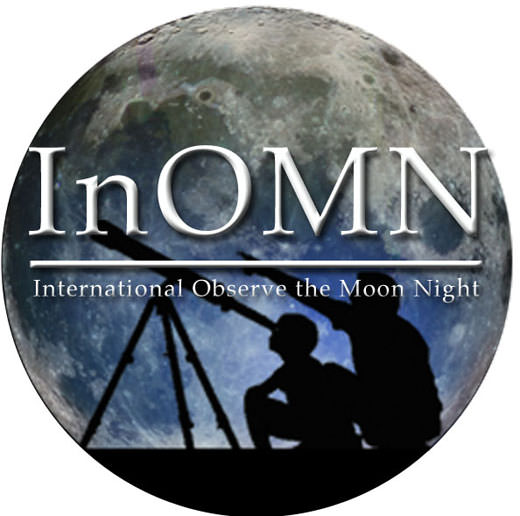China successfully launched their second robotic mission, Chang’E-2, to the Moon. A Long March 3C rocket blasted off from Xichang launch center just before 1100 GMT on October 1. The satellite is scheduled to reach the Moon in five days, and so far, all the telemetry shows everything to be working as planned. It will take some time for Chang’E-2 to settle into its 100-km (60-mile) orbit above the lunar surfaces, although the China space agency also said the spacecraft will come as close as 15km above the surface during its mission in order to take high-resolution imagery of potential landing sites for Chang’E-3, China’s next lunar mission that will send a rover to the Moon’s surface, scheduled for 2013.
Continue reading “China Launches Second Moon Mission”
The Moon’s South Pole as You’ve Never Seen it Before
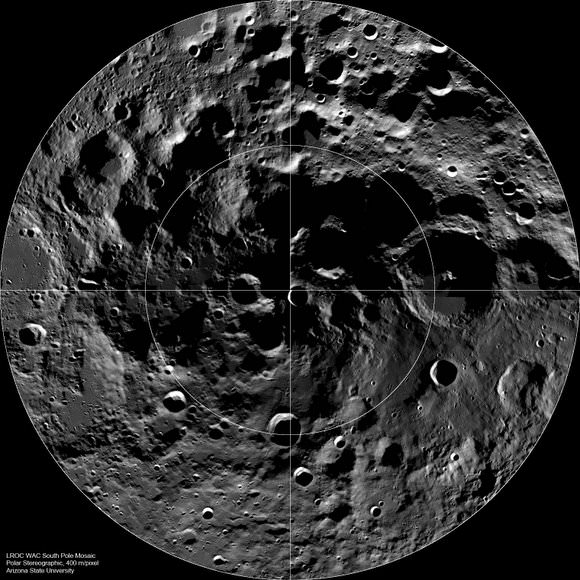
[/caption]
The lunar South Pole – a land of craters, shadows, intrigue and science! This wide-angle mosaic of the South Pole is one of the latest stunning images from the Lunar Reconnaissance Oribiter. The South Pole is the home of Cabeus Crater, where LCROSS impacted in 2009, as well as the Aitken Basin, which contains impact melt that will allow scientists to unambiguously determine the basin’s age, plus Shackleton crater, the region touted as the perfect place for future outposts and huge telescopes. The permanently shadowed regions in this crater wonderland could harbor reservoirs of ice and other volatiles contain a “priceless record of water composition dating back to the beginning of our Solar System, an incomparable dataset for astrobiology investigations,” said Mark Robinson, principal investigator for the Lunar Reconnaissance Orbiter Camera. “Additionally, these volatile deposits could serve as a tremendously valuable resource for future explorers.”
This is one of LROC’s first mosaics of the lunar South Pole, showing the region in all its glory. These mosaics are composed of several individual images taken by the wide-angle camera (WAC) on LRO that are stitched together. These big, beautiful images allow investigators to explore the geophysical and compositional properties of the lunar surface on a global or regional scale.

All the mosaics from the WAC and the two Narrow Angle Cameras (NAC) and WAC mosaics are produced using a specialized image-processing package called ISIS, the Integrated System for Imagers and Spectrometers. ISIS has the unique capability for processing data from several NASA spacecraft missions and when it applies, scientists can put everything together to get the big picture.
As LRO passes over the pole every two hours, the LROC WAC snaps an image, and over a month, images covering the entire polar region are captured. This mosaic contains 288 images taken in one month; if you look closely, you can see where the month began and ended at about 90°E longitude and note how the lighting changed. This makes the rim of Shackleton crater appear to be slightly disjointed. This is caused by how the Sun came from opposite sides for portions of the mosaic, resulting in opposite sides of the crater’s wall being illuminated in some images. As the mission progresses, the WAC will capture the pole across the full range of seasons and we’ll see even more spectacular views of this region, as well as the entire Moon.
Stay tuned!
Source: LROC website
Astrophysics From the Moon
Many astronomers feel that the Moon would be an excellent location for telescopes, — both on the surface and in lunar orbit – and these telescope could help answer some of the most important questions in astronomy and astrophysics today. One proposal calls for a lunar orbiting low frequency antenna that could measure the signatures of the first collapsing structures in the early universe. Dr. Jack Burns from the University of Colorado, Boulder, discussed the idea for the Lunar Cosmology Dipole Explorer (LCODE) at the NASA Lunar Science Institute’s Lunar Forum this summer.
“The Moon in many ways is a truly unique platform from which we can look outward into the cosmos and do some unique astronomical observations,” said Burns, who is also the Director of the NASA/NLSI Lunar University Network for Astrophysics Research (LUNAR).
What makes the Moon so inviting is that the lunar far side is uniquely radio quiet in the inner part of the solar system, as the far side is always facing away from the Earth, and the Moon itself blocks out any interfering man-made signals from radio, TV and satellites.
In this radio quiet zone, astronomers could study the very early universe, back to less than half a billion years after the Big Bang, probing what is called the Dark Ages, before the first stars and galaxies formed.
LCODE would be a satellite orbiting the Moon carrying a single dipole antenna, kind of like your car antenna, Burns said, but it has two ends. “It flies around the Moon and we take data only when we are above the far side, the shielded zone where we are free of radio interference,” said Burns, “and that allows us, because it is so quiet there, to take measurements of these very faint emissions from this very early era in our universe’s history.”

The orbiting dipole would allow scientists to look for these signals over the entire sky. If that is successful, the next stage would be to put an array of dipole antennas on the surface, perhaps even about ten thousand antennas, and use it as a radio interferometer that would “allow us to actually get some resolution to do some imaging,” Burns said, “and explore the composition of these structures in the early universe that eventually go on to form stars and galaxies.”
Other proposals for doing radio astronomy from the Moon would be to study the sun at low frequencies, below 10 megahertz. The sun emits very strong low frequency radio waves, and these are related to Coronal Mass Ejections, which produce very high energy particles which can interfere with satellites and could potentially be very harmful to future astronauts traveling in interplanetary space. “We hope to be able to image and to understand how these particles are accelerated,” Burns said.
The other interesting regions of the Moon from which to do astronomy would be the poles in permanently shadowed craters, which are very cold — only about 40 degrees above absolute zero – which would make an excellent site for infrared telescopes which need to be cooled down to very low temperatures.
You can listen to an interview with Jack Burns about LCODE on the 365 Days of Astronomy podcast.
The Moon in Stunning Wide Angle
[/caption]
Here’s a look at the Moon in a way we’ve never quite seen it before: a close up, but wide angle view. The Lunar Reconnaissance Orbiter camera actually consists of three cameras: there are two narrow-angle cameras which make high-resolution, black-and-white images of the surface, with resolutions down to 1 meter (about 3.3 feet). A third, a wide-angle camera (WAC), takes color and ultraviolet images over the complete lunar surface at 100-meter (almost 330-foot) resolution. However, the raw wide-angle images are somewhat distorted by the camera, but Maurice Collins, a Moon enthusiast from New Zealand, found that putting several images together in a mosaic removes a lot of the distortions and produces a much clearer image. The results are nothing short of stunning; here are a few example of Maurice’s handiwork, including this jaw-dropping image of the Marius Hills region of the Moon. Click on any of these images for a larger version on Maurice’s website, Moon Science
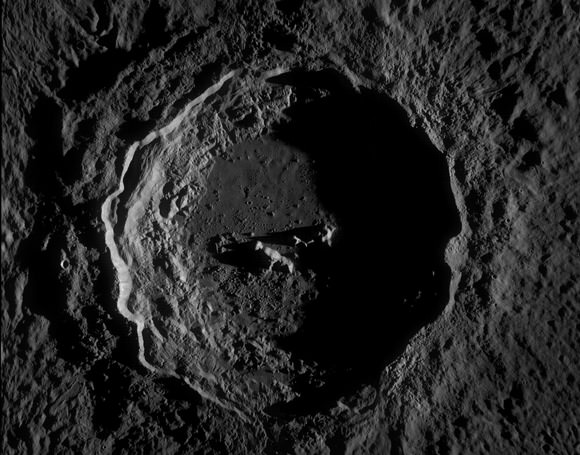
Maurice told me that he has been studying the Moon for about ten years now, and he does telescopic imaging of the Moon from his backyard Palmerston North, New Zealand as well as study the various spacecraft data. “I found out how to process the WAC images from Rick Evans (his website is here ) for the Octave processing method, and I also use a tool developed by Jim Mosher for another quicker technique,” Maurice said. Several of Maurice’s images have been featured on the Lunar Photo of the Day website.
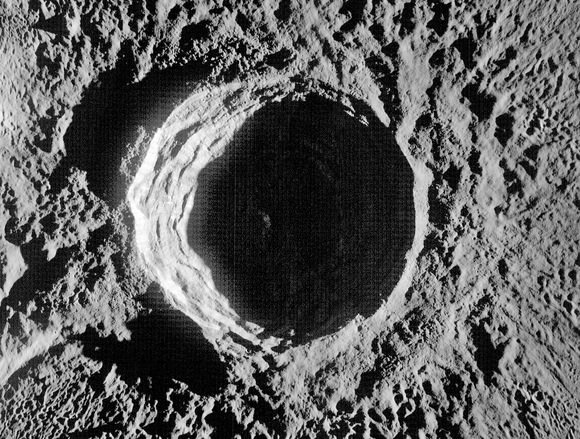
Other areas of lunar imaging work he has done is using the Lunar Terminator Visualization Tool (LTVT) to study the lunar topography from the Lunar Orbiter Laser Altimeter (LOLA) digital elevation model laser altimeter data.
“Using a previous DEM from the Kaguya spacecraft I discovered a new large (630km long) mountain ridge radial to the Imbrium basin which I have nicknamed “Shannen Ridge” after my 9 year old daughter,” he said. See the image of Shannen Ridge here.
Maurice said he is usually out every clear night imaging or observing the Moon with his telescope. Thanks to Maurice for his wonderful work, and for allowing us at Universe Today to post some of the images. Check out his complete cache of WAC mosaics at his website.
hat tip: Stu Atkinson!
Water on the Moon Could be Bad News for Future Lunar Astronomy
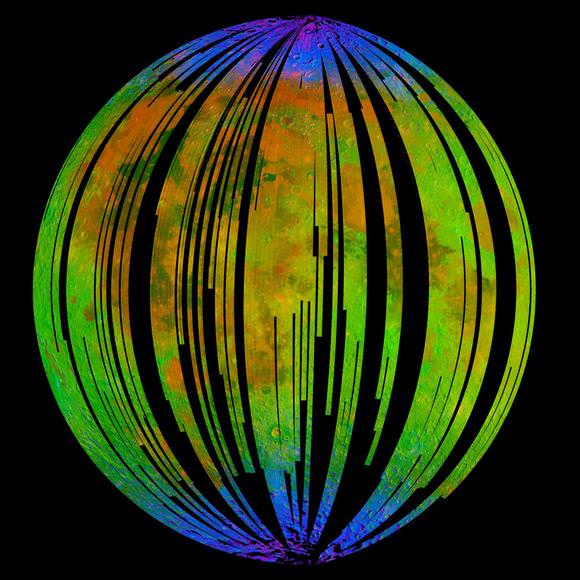
[/caption]
The recent discovery of water on the Moon may have a serious impact on future plans for lunar based astronomy. Space scientists from the Chinese Academy of Sciences have calculated that the scattering caused by molecules vaporized in sunlight could heavily distort observations from telescopes mounted on the Moon.
“Last year, scientists discovered a fine dew of water covering the Moon. This water vaporizes in sunlight and is then broken down by ultraviolet radiation, forming hydrogen and hydroxyl molecules. We recalculated the amount of hydroxyl molecules that would be present in the lunar atmosphere and found that it could be two or three orders higher than previously thought,” said Zhao Hua, who presented his team’s results at the European Planetary Science Congress in Rome.
The research has particular implications for the Chinese Lunar lander, Chang’E-3, which is planned to be launched in 2013. An ultraviolet astronomical telescope will be installed on the Chang’E-3 lander, which will operate on the sunlit surface of the Moon, powered by solar panels.
“At certain ultraviolet wavelengths, hydroxyl molecules cause a particular kind of scattering where photons are absorbed and rapidly re-emitted. Our calculations suggest that this scattering will contaminate observations by sunlit telescopes,” said Zhao.
The Moon’s potential as a site for building astronomical observatories has been discussed since the era of the Space Race. Lunar-based telescopes could have several advantages over astronomical telescopes on Earth, including a cloudless sky and low seisimic activity.
The far-side of the Moon could be an ideal site for radio astronomy, being permanently shielded from interference from the Earth. Radio observations would not be affected by the higher hydroxyl levels.
LRO Finds Bridges on the Moon
[/caption]
“Just when you think you have seen everything, LROC reveals a natural bridge on the Moon!” said Mark Robinson, Principal Investigator of the Lunar Reconnaissance Orbiter Camera (LROC), writing on the LROC website. “Who would have thought?” The natural bridge seen in this image is about 7 meters (23 feet) wide on top and perhaps 9 meters (30 feet) on the bottom side. Scientists estimate it would be a 20-meter (66-foot) walk to cross from one side to the other. While there are natural bridges here on Earth (which usually form as a result of wind and water erosion — see here for images of a natural bridge in Virginia in the US) how would such a natural structure form on the Moon? The answer might include another intriguing feature that has been found recently on the Moon: lava tubes.
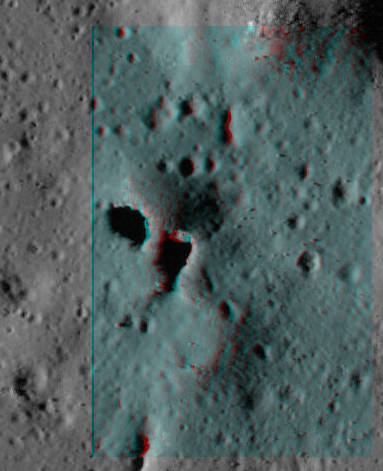
Robinson said the most likely way this feature formed is from a dual collapse into a lava tube. These are deep holes on the Moon that could open into vast underground tunnels, and could serve as a safe, radiation shielding habitats for future human lunar explorers.
There are actually a couple of these natural bridges that were found in just one region on the Moon, in the midst of an impact melt in the 15 km-wide King crater. Nathanial Burton-Bradford has created a few stereo images, which provide a unique perspective on these lunar bridges. Nathanial called the one below a “strange ‘twiglet’ ‘Monster Munch’ shape bridge.”
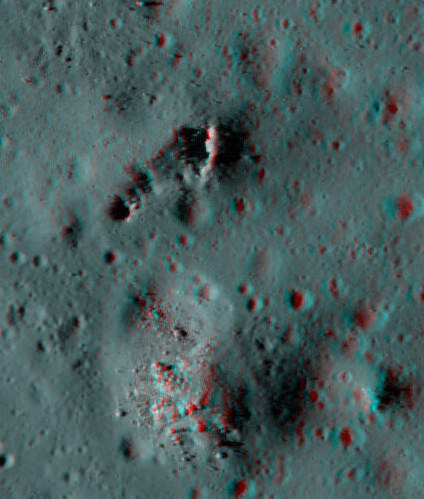
How can the lunar scientists be certain this feature really is bridge over a cavern? Look closely at the top image and in the pit on the west or left side, there is a small crescent of light on its floor. That patch of light came from the east, under the bridge.
Although Robinson and his team do not know for certain the details of how the bridge formed, here’s one possible scenario: The impact melt that was thrown out of the crater pooled on the newly deposited ejecta and must be many tens of meters thick, allowing its interior to stay molten for a long time. As the local terrain readjusted after the shock of the impact, the substrate of this massive pool of melt was jostled to some degree. Local pressures built up and the melt moved around under a deforming crust. You can see that the south end of the bridge extends from a small local rise, shaped something like a blister. Perhaps some melt was locally pushed up forming the rise, then the magma found a path to flow away, leaving a void which the crusted roof partially collapsed.
The LROC team is working on making their own stereo images, but in the meantime, thanks to Nathanial Burton-Bradford for providing us with a preview!
See more on the LROC website, and at Nathanial’s Flickr page.
September 18 is International Observe the Moon Night
[/caption]
There’s nothing like gazing at the Moon on a clear night, especially when you can share it with someone. Why not share it with the world? September 18, 2010 is the first annual International Observe the Moon Night, and this is planned to become an annual event to engage the public and raise awareness about the night sky and particularly the Moon, as well as spreading the word about NASA’s work in lunar research and exploration. Event planners hope to bring people together with both professional and amateur astronomers, and there are events planned all around the world and on the world wide web, as well.
“Last year NASA Ames and NASA Goddard each had individual events that were very successful, so we decided to do it again, but make it bigger and better and ask the rest of the world to join in,” said Doris Daou, who is the Director of Communications and Outreach for the NASA Lunar Science Institute.
Last year’s events celebrated the Lunar Reconnaissance Orbiter’s successful orbit insertion around the Moon and the Goddard Center hosted an event called “We’re at the Moon!” while NASA Ames had a “National Observe the Moon Night.”
“Since this year is now an international event, we have an overarching theme, ‘Seeing the Moon in a Whole New Light,’ which is largely based on the fact that we have all this wonderful new data that has come back during the past year from the Lunar Renaissance Orbiter as well as the Chandrayaan-1 spacecraft and other spacecraft,” said Lora Bleacher the Informal Education Lead for the LRO mission.
“LRO is changing our understanding and our view of the Moon,” said Brian Day, the Education and Public Outreach Lead for NASA’s Lunar Atmosphere and Dust Environment Explorer Mission (LADEE). “All the recent lunar news has raised the public’s consciousness of the Moon to a whole new degree. It’s exciting to see the heightened level of interest that the public has in the Moon now, and our understanding of the moon has changed radically over a short amount of time. So we are giving everyone the opportunity to conduct their own personal explorations of the lunar surface and in doing so learn about how our understanding of the Moon has changed.“
Amateur and professional astronomers will be sharing first hand views of the Moon with the public, for example, the Night Sky Network, which is a collaboration between NASA and the Astronomy Society of the Pacific and is an organization of some 300 amateur astronomy clubs across the US will be holding events. Other NASA centers, museums, and science centers are involved, and the event has also caught on internationally, lead by international partners of the NASA Lunar Science Institute, Astronomers Without Borders, and other groups.
“Not only will people be able to come to a location near them and look through a telescope, which I highly recommend,” said Day, “there will also be presentation by local lunar experts.”
To see if there is an event near you, visit the InOMN website. There are also star charts, Moon maps, and information on how you can host your own event.
You can also follow @observethemoon on Twitter to share your Moon-watching experiences in that venue.
Also, you can listen to a 365 Days of Astronomy/NLSI podcast I did about InOMN.
Moon Zoo is participating with an online challenge for the Zooites to classify 20,000 images between now and the end of September 19th (midnight BST). With everyone’s help they hope to add 440 square kilometers (275 square miles) of features that will be classified on the Moon, which is the size of the Dead Sea, or twice the size of Metropolitan Chicago. In total, Moon Zoo has already provided the lunar science community with information on the locations of craters, spacecraft, and geologic features such as rilles and boulder fields for more than 38,600 square kilometers (24,000 square miles) of lunar terrain. You can follow the progress on the “Moonometer.”
Event organizers are already looking towards the future and keeping the Moon momentum going. Next year’s theme will have a cultural focus to celebrate what the Moon means to people around the world.
“This is an annual event that will happen every year around the same time depending what phase of the Moon we’ll be in,” said Daou, “but also throughout the year we’ll be having bits and pieces of new regarding the Moon on our website, so don’t wait until the Fall to see what is new on our website!
LRO Takes Closer Look at Moon Caves
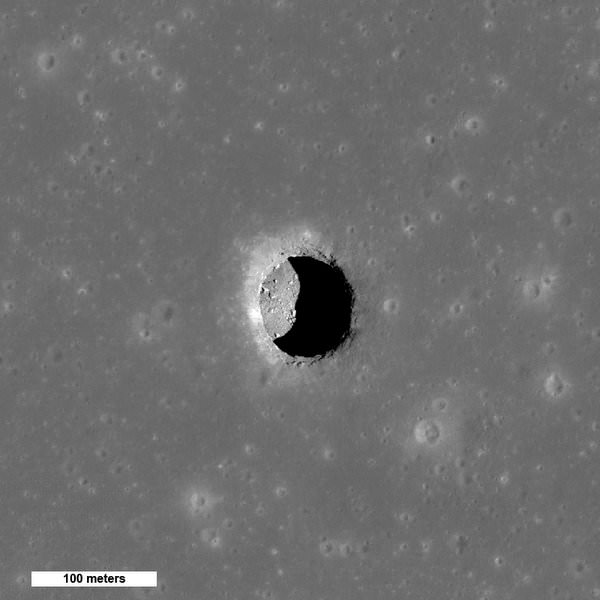
As promised, the Lunar Reconnaissance Orbiter is taking more detailed looks at the lunar pits, or lava tubes that have been discovered by LRO and the Kaguya spacecraft. These are deep holes on the moon that could open into vast underground tunnels, and could serve as a safe, radiation shielding habitats for future human lunar explorers. Plus, they are just plain intriguing! This image of a pit found in the Sea of Tranquility (Mare Tranquillitatis) was taken as the Sun was almost straight overhead, illuminating the region. By comparing this image with previous images that have different lighting, scientists can estimate the depth of the pit. They believe it to be over 100 meters!
See more “in-depth” look at more of the caves on the Moon, below:

These two images show a pit in Mare Ingenii, which reveal different portions of the floor as the Sun crosses from west to east. Again, by measuring the shadows in different lighting, the Sea of Cleverness pit appears to be about 70 meters deep and about 120 meters wide.
These long, winding lava tubes are like structures we have on Earth. They are created when the top of a stream of molten rock solidifies and the lava inside drains away, leaving a hollow tube of rock. There have been hints that the Moon had lava tubes based on observations of long, winding depressions carved into the lunar surface by the flow of lava, called sinuous rilles.
If a human geologist could ever climb down inside these tubes on the Moon, we could learn so much about the Moon’s history, and sort of travel back in time by studying the different layers on the Moon, just like we do on Earth.

LROC has now imaged the Marius Hills pit three times, each time with very different lighting. The center view has an incidence angle of 25° that illuminates about three-quarters of the floor. The Marius pit is about 34 meters deep and 65 by 90 meters wide.
Read more about the Ingenii, Tranquillitatis, and Marius pits at the LROC website, and you can search the nearby area for clues in the full LROC NAC frame that may help determine if an extended lava tube system still exists beneath the surface.
Source: LROC website
Tonight’s the Night Mars Will NOT Look as Big as the Full Moon
[/caption]
I wasn’t going to write an article about the Mars-Moon Hoax this year because I thought it was too passé — we’ve written articles about this email-circulated fallacy every year since 2003 and another article would be like beating a dead horse because surely, there’s no one out there anymore that actually believes Mars can look as big as the full Moon.
But I just looked at some stats and saw that our article on the topic from 2007, “Will Mars Look as Big as the Full Moon On August 27? Nope” has gotten like a gazillion hits the past few days, so obviously people are Googling the topic, wondering if Mars will look as big as the full Moon tonight.
Short answer: No. If you looked at the night sky last night, Mars was not as big as the full Moon then, and it won’t be that big tonight. Moreover, it won’t be that big, ever. It is impossible for Mars to ever look as big as the full Moon. And this year (2010) in August, Mars is just barely visible, as a faint object low in the west after sunset. Take a look at the sky chart above from EarthSky.org which shows you where it is. And you can read more about Mars in 2010 at the EarthSky.org website, which is a great resource for all sorts of science topics and is written by some of the world’s top scientists.
The confusion arises from an erroneous and completely hoaxy email that started in 2003 when Mars was about as close to Earth it will ever get, but still, it was very far away, about 55,758,006 kilometers (34,646,418 miles). It did not look as big as the full Moon then, and it certainly never will. Take a look at JPL’s blog post, “Five Things About Viewing Mars in August” written by outreach specialist Jane Houston Jones. She writes:
“The moon is one-quarter the size of Earth and is relatively close — only about 384,000 kilometers (about 239,000 miles) away. On the other hand, Mars is one-half the size of Earth and it orbits the sun 1-1/2 times farther out than Earth’s orbit. The closest it ever gets to Earth is at opposition every 26 months. The last Mars opposition was in January and the next one is in March 2011.
At opposition, Mars will be 101 million kilometers (63 million miles) from Earth, almost twice as far as in 2003. So from that distance, Mars could never look the same as our moon.”
NASA usually writes an article about this every year as well — and this year it is called “The Mutating Mars Hoax.”
Every year, Universe Today has been debunking the erroneous email that has been going around since 2003. If you’d like to look back, here are a few: 2009, 2008, 2007, 2006, and 2005. If you don’t believe Fraser and me, Phil Plait the Bad Astronomer debunks the email here, here , here, and here’s the original one back in 2003.
And by the way, I stole the title for this article from my friend Rob Sparks, who said on Twitter this morning, “Today’s the day Mars won’t look as big as the full Moon.” He wrote a great blog post about the Mars-Moon hoax on his “Half-Astrophysics” blog.
So, yes, tonight is the night Mars will NOT look as big as the full Moon, and that goes for every other night, as well.
Just remember, you can’t always believe everything you read in a forwarded email!
First Quarter Moon
[/caption]
The first quarter moon is actually the third phase of the moon each cycle. In the Northern Hemisphere during this phase, the right hand 50% of the moon is visible during the afternoon and the early part of the night. In the Southern Hemisphere the left hand 50% of the moon can be seen. This lunar phase follows the new moon and the waxing crescent.
A lunar phase is the appearance of an illuminated portion of the moon as seen by an observer. For this article the observer is always on Earth. The lunar phases vary in a definite cycle as the moon orbits the Earth. The phases change based on the changing relative positions of the Earth, moon, and Sun. Half of the moon’s surface is always illuminated by the Sun, but the portion of the illuminated hemisphere that is visible to an observer can vary from 100%(full moon) to 0%(new moon). The only exception is during a lunar eclipse. The boundary between the light and dark portions of the moon is called the terminator.
There are 8 moon phases. These phases are: new moon, waxing crescent, first quarter moon, waxing gibbous, full moon, waning gibbous, last quarter moon, and waning crescent. The phases progress in the same manner each month. Earlier, it was mentioned that the lunar phase depends on the position of the Earth, moon, and Sun. During the new moon the Earth and Sun are on the opposite side of the moon. During the full moon the Earth and Sun are on the same sides of the Moon. The occasions when the Earth, Sun, and moon are in a straight line(new and full moon) are called syzygies.
When the moon passes between Earth and the Sun during a new moon, you might think that its shadow would cause a solar eclipse. On the other hand, you might think that during a full moon the Earth’s shadow would cause a lunar eclipse. The plane of the moon’s orbit around the Earth is tilted by about five degrees compared to the plane of Earth’s orbit around the Sun(called the ecliptic plane). This tilt prevents monthly eclipses. An eclipse can only occur when the moon is either new or full, but it also has to be positioned near the intersection of the Earth’s orbital plane about the Sun and the Moon’s orbit plane about the Earth, so there are between four and seven eclipses in a calendar year.
The first quarter moon is only one of eight lunar phases. You should research them all for a better understanding of the Earth/Moon system.
We have written many articles about the phases of the moon for Universe Today. Here’s an article about the 8 phases of the moon, and here’s an article about the moon phases for 2010.
If you’d like more info on the Moon, check out NASA’s Solar System Exploration Guide on the Moon, and here’s a link to NASA’s Lunar and Planetary Science page.
We’ve also recorded an entire episode of Astronomy Cast all about the Moon. Listen here, Episode 113: The Moon, Part 1.
References:
http://spaceplace.nasa.gov/en/kids/phonedrmarc/2004_march.shtml
http://starchild.gsfc.nasa.gov/docs/StarChild/questions/question3.html


